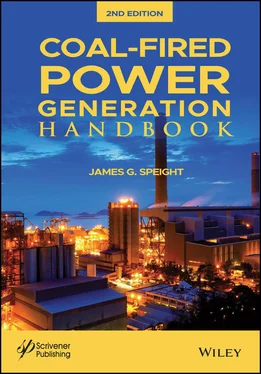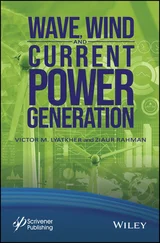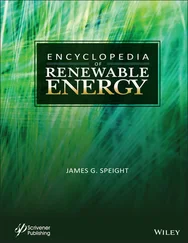Oxidation is an exothermic reaction and, since the rate of a chemical reaction increases for each 10°C (18°F), the reaction will generate heat at a faster rate than can be dissipated or expelled from the stockpile by natural ventilation. Hence, the temperature will rise to a point where spontaneous ignition occurs and combustion ensues.
The risk of spontaneous combustion during final preparation such as in silos/bunkers and mills also presents concerns in some cases. Properties which influence the propensity of coal to self-heat include volatile content, coal particle size, rank, heat capacity, heat of reaction, the oxygen content of coal and pyrite content. The propensity of coal to self-heat and spontaneously combust tends to increase with decreasing rank. Thus, lignite and sub-bituminous coal are more prone to spontaneous combustion than bituminous coals and anthracites.
The temperature at which the coal oxidation reaction becomes self-sustaining and at which spontaneous combustion occurs varies generally depending on the type (nature and rank) of coal and the dissipation (or lack thereof) of the heat. For low-quality coal and where the heat retention is high, the coal start burning at temperatures as low as 30 to 40°C (86 to 104°F).
Thus, the temperature of coal increases due to self-heating until a plateau is reached, at which the temperature is temporarily stabilized. At this point, heat generated by oxidation is used to vaporize the moisture in the coal. Once all the moisture has been vaporized, the temperature increases rapidly. On the other hand, dry material can readily ignite following the sorption of water – dry coal in storage should not be kept in a damp place because this can promote self-heating. Therefore, it is recommended that dry and wet coal be stored separately.
Complications may also arise in the case of coals with high moisture and sulfur content and those with tendencies to degrade when exposed to aerial oxygen. This is a critical issue in the case of low-rank, high-sulfur coals. Lignite and subbituminous coal are difficult to store without occurrence of spontaneous combustion, in contrast to anthracite where the potential for spontaneous ignition to occur is minimal.
Thus, oxidation of the coal substance proper is the primary cause of spontaneous heating. This heating, however slight, is caused by slow oxidation of coal in an air supply which is sufficient to support oxidation but not sufficient to carry away all heat formed and proceeds whenever a fresh coal surface is exposed to air (Berkowitz and Speight, 1973).
Thus, coal presents hazards between the time it is mined and its eventual consumption in boilers and furnaces. Below are listed some of the characteristics of the factors that contribute to spontaneous ignition/combustion in coal stockpiles and which can be used to evaluate the potential for coal fires and as guidelines for minimizing the probability of a fire.
The relationship between the friability of coal and its rank has a bearing on its tendency to undergo spontaneous heating and ignition (Chakravorty, 1984; Chakravorty and Kar, 1986). The friable, low-volatile coals, because of their high rank, do not oxidize readily despite the excessive fines and the attendant increased surface they produce on handling. Coals of somewhat lower rank, which oxidize more readily, usually are relatively non-friable; hence they resist degradation in size with its accompanying increase in the amount of surface exposed to oxidation. But above all, the primary factor in coal stockpile instability is unquestionably oxidation by atmospheric oxygen whilst the role of any secondary factors such as friability is to exacerbate the primary oxidation effect (Jones and Vais, 1991).
Thus, spontaneous combustion is a rank-related phenomenon. The tendency of coal for self-heating decreases as the rank increases, with lignite and subbituminous coals being more susceptible to self-heating than bituminous coals and anthracite (Pis, 1996). As rank decreases, inherent moisture, volatile matter and oxygen and hydrogen contents increase. Medium- to high-volatile coal with the ability to produce yields of volatile matter content in excess of 18% w/w daf perform a faster oxidation rate coal that produces a lower yield of volatile matter and are therefore more prone to spontaneous combustion. Furthermore, low-rank coals often have a greater porosity than higher-rank coal and therefore more surface area is available for oxidation. Low-rank coals also contain long chain hydrocarbon derivatives, thereby rendering the coal less stable than, for example, the high-rank anthracite coal which has a lower hydrocarbon component. However, the oxidation rate for coals of the same rank may show variety within a wide range.
Coal is highly variable (due to the rank of the coal) in the ability to absorb oxygen (thereby weathering or causing combustion) and oxygen absorption generally decreases with increasing rank, i.e., low for anthracite and high for subbituminous coal and lignite (Fieldner et al ., 1945). Oxygen absorption is also higher for those coals with high bed moisture (natural bed moisture, determined as capacity moisture , natural bed moisture, equilibrium moisture (ASTM D1412), oxygen content, and volatile content, i.e., the low-rank coals (Speight, 2005, 2008, 2013).
It is generally (but not totally) accepted that the mechanism of the oxidation of coal oxidation takes place in five steps, each one chemically dependent upon the temperature. These steps are (i) the coal begins to oxidize slowly until a temperature of approximately 50°C (122°F) is reached, (ii) at this point, the oxidation reaction increases at an increasing rate until the temperature of the coal is approximately 100 to 140°C (212 to 285°F), (iii) at approximately 140°C (285°F), carbon dioxide and water vapor are produced and expelled from the coal, (iv) liberation of carbon dioxide increases rapidly until a temperature of 230°C (445°F) is reached, at which stage spontaneous ignition may occur and spontaneous combustion may take place, and (v) at 350°C (660°F), the coal spontaneously ignites and vigorous combustion occurs (Barkley, 1942; Parry, 1942; Roll 1963).
At low temperature, the first step is developed faster than others and is often recognized as the rate determining step . Oxygen molecules are connected to the coal surface physically (adsorption) and reaches to the passing pores by diffusion. In this stage, since the oxide layer formed with the exposure of coal surface to the air prevents the diffusion of oxygen partially, oxidation rate is decreased in time.
The overall reaction is exothermic (releasing 94 kcal/mole of thermal energy) and the heat produced is generally (or should be) carried away from the reaction site by airflow and there is not any significant change in ambient temperature. However, in some cases formed heat cannot be carried away from the environment and the temperature begins to increase. The reaction gets accelerated and spread over with the increasing temperature; produced heat takes the coal to ignition temperature (approximately 175°C, 345°F) in suitable conditions and open flamed fire begins. Thus, without removal of the heat from the stockpile, the oxidation and heat generation can be (and will be) self-perpetuating especially since the rates of organic chemical reactions usually double for every 10°C (18°F) rise in temperature. The time passed from the beginning of oxidation to reaching the ignition temperature is the incubation period .
Furthermore there has also been the suggestion that the heat release which accompanies the wetting of dried (or partially dried) coal may be a significant contributory factor in the onset of burning. Support for such a concept is derived from the observations that stored coal tends to heat up when exposed to rain after a sunny period (during which the coal has been allowed to dry) or when wet coal is placed on a dry pile (Berkowitz and Schein, 1951). Therefore, it may be unwise to stockpile wet coal or to store coal on a damp base if it can be avoided. After a rain or snowstorm a coal pile should be carefully inspected.
Читать дальше












